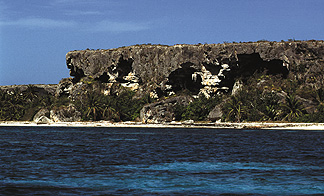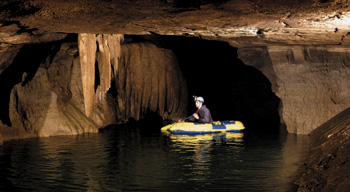geotimesheader
Highlights
Caves
and Karst
John E. Mylroie
| Cave and karst science got a strong
start last year with the Karst Modeling Conference, sponsored by the Karst
Waters Institute and held Feb. 24-27, 1999, in Charlottesville, Va. Covering
conceptual models, analytical models, digital models, scale models, statistical
models, and acquisition and application of field data, the conference followed
a trend of attempts to bridge the gaps between theoretical analyses and
practical applications.
As summarized by Arthur Palmer, a board member
emeritus
of
the Karst Waters Institute, the meeting addressed such aspects of karst
modeling as groundwater flow patterns, velocities and divides; distribution
of porosity and permeability; interaction |

The sheer cliffs along the coast of Isla de Mona, west of Puerto Rico,
contain
a conspicuous horizon of solutional caves in Miocene carbonates. The
distribution of caves and their sedimentary deposits in such carbonate
islands
provide clues to late Cenozoic sea-level fluctuation, tectonic uplift and
mixing
between freshwater and seawater.
Arthur N. Palmer. |
of fluids among porosity types; storage characteristics
of pore network; groundwater geochemistry; well-head protection areas;
fate and transport of contaminants; groundwater monitoring and remediation
strategies; land subsidence and foundation stability; and stormwater management.
The talks covered traditional conduit flow models, dual and triple porosity
karst aquifer models, fracture flow as a model for karst, paleokarst, mixed-fluid
systems, mass and water budgets, and interesting case histories. Increased
computer power has created more sophisticated models. At the same time,
underlying assumptions are being questioned and refined as we get better
data from field settings. Much of the research, and therefore the funding,
is being driven by the need to understand contaminant transport in karst
settings, where traditional Darcian flow models don’t work. A complete
account of the meeting is available as a proceedings volume from www.karstwaters.org.
While the Karst Modeling Conference had a strong
theoretical bent, the Seventh Multidisciplinary Conference on Sinkholes
and the Engineering and Environmental Impacts of Karst (also called the
“Sinkhole Conference”) was held April 10-14 in Harrisburg, Penn., to explore
applying cave and karst knowledge to dealing with land use in karst areas.
Sponsored by P.E. LaMoreaux and Associates, this series began in 1984 and
has become the premier forum for applied geology and engineering in karst
terrains. As a result, the proceedings of these conferences (published
by A. A. Balkema) have become a critical reference source for consultants
and regulators. The influx of ideas and experience from overseas speakers
— from Belgium, Canada, Croatia, France, India, Ireland, Kuwait,
Lithuania, Russia, Slovenia, Spain and the United Kingdom — presented
karst land-use solutions that were creative and often extremely economical.
A special session on highways in karst was timely, as more areas undergo
development. The application of sophisticated geophysical techniques and
modeling has resulted in karst engineering becoming less reactive and more
proactive.
 |
The National Speleological Society held its annual
meeting in Filer, Idaho, July 12-16, 1999, which included a symposium
on sulfuric-acid karst. The oxidation of hydrogen sulfide from hydrocarbon
reservoirs to create cave-generating acids remains a hot topic. The concept
is being refined by more study of reactant and product transport mechanisms,
argon dating of alunite, the role of microbes in karst processes, and the
origin of secondary gypsum within carbonate rocks. Additionally, the setting
of the meeting was used to present pseudokarst processes associated with
volcanic terrains. |
The main stream passage of Blue Spring Cave, Ind. The distribution of
cave
passages in the Ohio River valley has helped to clarify the history of
fluvial
erosion and deposition in the region, Recent dating of quartz
sediment
in the cave's valley with cosmogenic radionuclides has
quantified
the stages in the drainage evolution of the Ohio basin.
Arthur
N. Palmer. |
The October Geological Society of America (GSA)
meeting in Denver last October included a session called, “Sediments in
Karst Systems: Processes, Mechanisms, Interpretation.” Sponsored by the
GSA Hydrogeology Division, the GSA Quaternary Geology |
and Geomorphology Division, the GSA Sedimentology
Division, and the Karst Waters Institute, the session was the meeting’s
third largest with 38 abstracts. These were divided about equally between
chemical and clastic sediment topics. The main focus was use of cave deposits
as paloeclimatic indicators. Paleoclimate case-history interpretations
via stable isotope analyses of speleothems, placed in a chronology by uranium/thorium
dating, dominated the presentations of chemical cave sediments. Henry Schwarcz
of McMaster University pointed out pitfalls in interpreting 18O
and 13C data. The clastic cave sediment presentations were more
varied, addressing contaminant transport on fine-grained cave sediments,
vertebrate fossils as climatic indicators, paleokarst records, and cosmogenic
26Al/10Be
dating of sediments.
Karst Science Award
The Karst Waters Institute initiated the Karst
Science Award last year to recognize individuals who have made significant
contributions to the understanding of karst processes. The inaugural recipient
was Derek Ford, recently retired from McMaster University, who was recognized
for his numerous achievements spanning four decades.
Mylroie teaches geology at
Mississippi State University, is a board member for the Karst Waters Institute
and is a fellow of the National Speleological Society. E-mail: Mylroie@Geosci.MsState.edu


